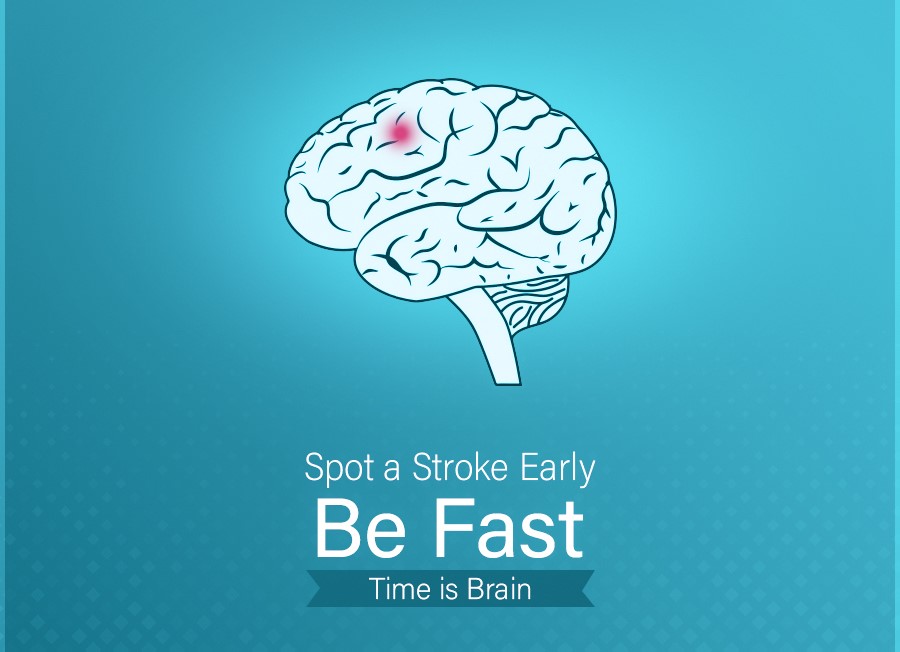Stroke : Facts & Prevention
Home » Stroke : Facts & Prevention

A 54 year old male, an active professional and is the only earning member of the family woke-up from bed in the morning and realized that he was unable to move the right hand and leg. Also, he was finding it hard to utter a word and was looking confused. His family rushed him to the nearby hospital where the doctors performed a scan of the brain. The image indicated that a portion of the left side of brain was damaged due to blockage of blood supply to that portion of brain. He was immediately administered medications and subsequently subjected to physiotherapy. But, at the end of 1 year, he remained to be paralyzed and is being taken care by his family.
The above incidence is a typical case of STROKE, also known as brain attack or cerebrovascular accident. It is one of the leading causes of death and disability in the world. Stroke is defined by loss of function of a portion of brain due to sudden block in blood vessels that carries oxygen and nutrients to brain. It is the same mechanism as heart attack (which is caused by block in blood vessels to heart). The major difference between heart attack and brain attack is that the heart function is uniform, and loss of small portion of heart is compensated by other areas; whereas brain has different functions in different areas and loss of a portion of brain area is irreversible and cannot be compensated by other areas.
This is the major cause of functional incapacity following stroke. Hence, even when a person survives following a stroke, the paralysis and loss of ability to speak make the person to be permanently disabled. They become dependent for rest of the life even for their day to day routine activities.
According to statistics given in Indian Journal of Medical Research “Prevalence of stroke in our country is 55.6 per 100,000 population. 1.44 – 1.64 million cases of new acute strokes are diagnosed every year which includes 0.63 million deaths. 12% of strokes occurs in the population aged < 40 years (stroke in young”. The major risk factors for stroke are uncontrolled high blood pressure, diabetes, high cholesterol levels, smoking, alcohol consumption and lastly stroke in other family members. Many times, stroke can give a warning signal called transient ischemic attack – a phenomenon wherein patients develop transient weakness of hand and leg and speech disturbances which recover shortly. When they ignore these symptoms, they land up subsequently in a major stroke.
The management of stroke has dramatically advanced over the past few years. If one could reach the hospital which deals with stroke care within 4 – 6 hours on onset of stroke, the blood circulation could be reestablished and a major stroke can be prevented. Delay in getting to the hospital and receiving appropriate treatment can cause irreversible damage and further treatment would only be supportive care and most often cannot restore the damaged brain function.
How to Prevent a Stroke
As far as stroke is concerned, prevention is always better than cure. Adequate control of blood pressure, blood sugar, cholesterol is of paramount importance. To quit smoking and alcohol consumption helps in a large way to prevent stroke. Adequate hydration and adopting healthy lifestyles like walking and other exercises can maintain a healthy blood circulation and thus prevent stroke.
The important blood vessels which carries nutrition and oxygen from heart to brain run through the neck. In a proportion of patients, these blood vessels can be blocked partially or completely and this can be totally missed if only brain scan is done following a stroke. Hence, in patients presenting minor or major stroke, we need to investigate not only the head but also the neck. If there is a block in the main vessel in the neck and if it exceeds 70% of the total diameter, medicine alone will not be helpful. The block must be relieved by a procedure called Endarterectomy, wherein that portion of blood vessel in the neck must be opened and cleared of all obstructing elements and closed watertight. This will re-establish normal blood circulation to the brain and thereby eliminate the risk of stroke to a large extent. In patients who are medically unfit to undergo this procedure, a stent can be placed across the blocked segment through a small puncture in thigh.
However, if the blood vessel is completely blocked, it is not possible to open the entire length of vessel. In such instances, we must investigate further as to whether there is compensation of blood flow from the other side of neck in which case medical treatment should be sufficient but with careful and periodic health check-up. If doubt remains about compensation of flow, one need to challenge the brain by some medication which causes sudden increase in flow. If brain fails the challenge, then bypass surgery for the brain must be performed. Here the blood vessels which are carrying blood to skin of the head or face can be diverted to brain by making a small hole in the skull. This would ensure that the brain gets adequate nutrition and oxygen supply through the small blood vessels even though the main vessel in the neck remains to be blocked.
These procedures like Endarterectomy and Cerebral Bypass are under-utilized and they can help to a large extent to prevent stroke which otherwise could prove catastrophic and lethal.

